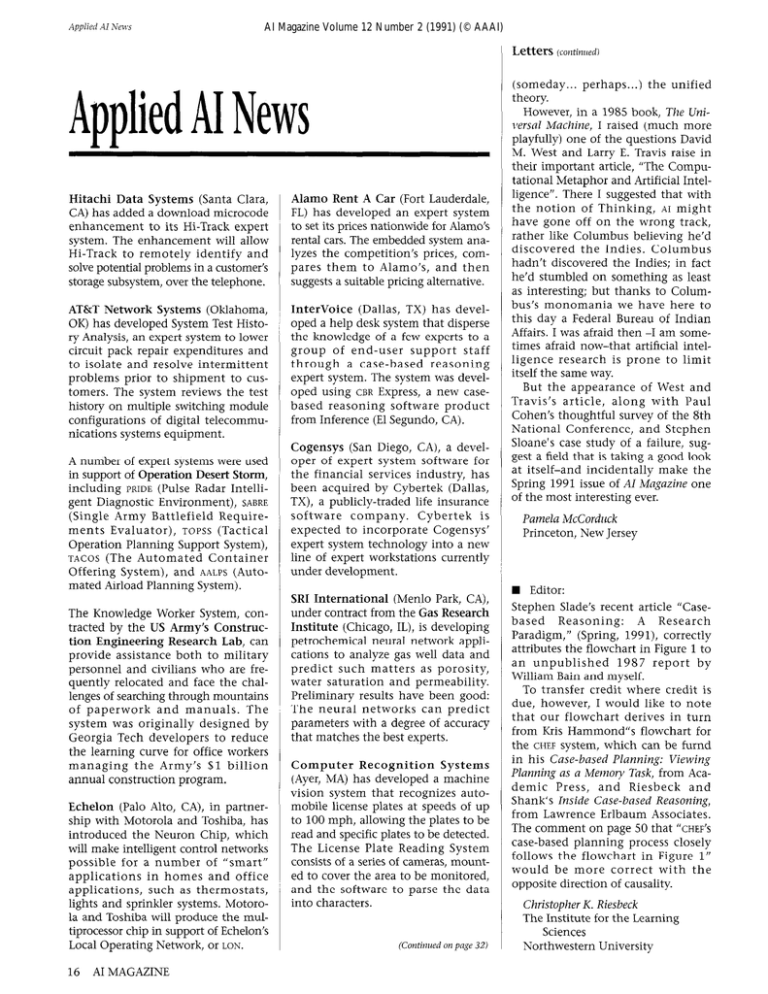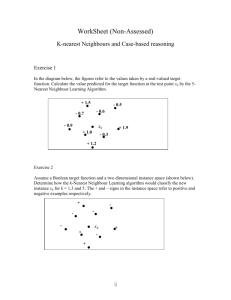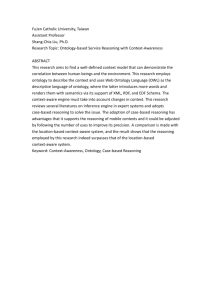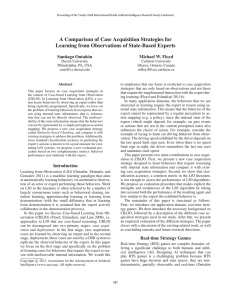Applied AI News
advertisement

Applied AI News AI Magazine Volume 12 Number 2 (1991) (© AAAI) Letters Applied AINews Hitachi Data Systems (Santa Clara, CA) has added a download microcode enhancement to its Hi-Track expert system. The enhancement will allow Hi-Track to remotely identify and solve potential problems in a customer’s storage subsystem, over the telephone. Alamo Rent A Car (Fort Lauderdale, FL) has developed an expert system to set its prices nationwide for Alamo’s rental cars. The embedded system analyzes the competition’s prices, compares them to Alamo’s, and then suggests a suitable pricing alternative. AT&T Network Systems (Oklahoma, OK) has developed System Test History Analysis, an expert system to lower circuit pack repair expenditures and to isolate and resolve intermittent problems prior to shipment to customers. The system reviews the test history on multiple switching module configurations of digital telecommunications systems equipment. InterVoice (Dallas, TX) has developed a help desk system that disperse the knowledge of a few experts to a group of end-user support staff through a case-based reasoning expert system. The system was developed using CBR Express, a new casebased reasoning software product from Inference (El Segundo, CA). A number of expert systems were used in support of Operation Desert Storm, including PRIDE (Pulse Radar Intelligent Diagnostic Environment), SABRE (Single Army Battlefield Requirements Evaluator), TOPSS (Tactical Operation Planning Support System), TACOS (The Automated Container Offering System), and AALPS (Automated Airload Planning System). The Knowledge Worker System, contracted by the US Army’s Construction Engineering Research Lab, can provide assistance both to military personnel and civilians who are frequently relocated and face the challenges of searching through mountains of paperwork and manuals. The system was originally designed by Georgia Tech developers to reduce the learning curve for office workers managing the Army’s $1 billion annual construction program. Echelon (Palo Alto, CA), in partnership with Motorola and Toshiba, has introduced the Neuron Chip, which will make intelligent control networks possible for a number of “smart” applications in homes and office applications, such as thermostats, lights and sprinkler systems. Motorola and Toshiba will produce the multiprocessor chip in support of Echelon’s Local Operating Network, or LON. 16 AI MAGAZINE Cogensys (San Diego, CA), a developer of expert system software for the financial services industry, has been acquired by Cybertek (Dallas, TX), a publicly-traded life insurance software company. Cybertek is expected to incorporate Cogensys’ expert system technology into a new line of expert workstations currently under development. SRI International (Menlo Park, CA), under contract from the Gas Research Institute (Chicago, IL), is developing petrochemical neural network applications to analyze gas well data and predict such matters as porosity, water saturation and permeability. Preliminary results have been good: The neural networks can predict parameters with a degree of accuracy that matches the best experts. Computer Recognition Systems (Ayer, MA) has developed a machine vision system that recognizes automobile license plates at speeds of up to 100 mph, allowing the plates to be read and specific plates to be detected. The License Plate Reading System consists of a series of cameras, mounted to cover the area to be monitored, and the software to parse the data into characters. (Continued on page 32) (contirmed) (someday... perhaps...) the unified theory. However, in a 1985 book, Tfze UnilJersnZMachine, I raised (much more playfully) one of the questions David M. West and Larry E. Travis raise in their important article, “The Computational Metaphor and Artificial Intelligence”. There I suggested that with the notion of Thinking, AI might have gone off on the wrong track, rather like Columbus believing he’d discovered the Indies. Columbus hadn’t discovered the Indies; in fact he’d stumbled on something as least as interesting; but thanks to Columbus’s monomania we have here to this day a Federal Bureau of Indian Affairs. I was afraid then -1 am sometimes afraid now-that artificial intelligence research is prone to limit itself the same way. But the appearance of West and Travis’s article, along with Paul Cohen’s thoughtful survey of the 8th National Conference, and Stephen Sloane’s case study of a failure, suggest a field that is taking a good look at itself-and incidentally make the Spring 1991 issue of AI Maguzine one of the most interesting ever. Pamela McCordztck Princeton, New Jersey Editor: Stephen Slade’s recent article “Casebased Reasoning: A Research Paradigm,” (Spring, 1991), correctly attributes the flowchart in Figure 1 to an unpublished 1987 report by William Bain and myself. To transfer credit where credit is due, however, I would like to note that our flowchart derives in turn from Kris Hammond”s flowchart for the CHEF system, which can be furnd in his Case-based Planning: Viewing Planning as c1Memory Task, from Academic Press, and Riesbeck and Shank’s Inside Case-based Reasoning, from Lawrence Erlbaum Associates. The comment on page 50 that "CHEF'S case-based planning process closely follows the flowchart in Figure 1” would be more correct with the opposite direction of causality. n Christopher K. Riesbeck The Institute for the Learning Sciences Northwestern University



